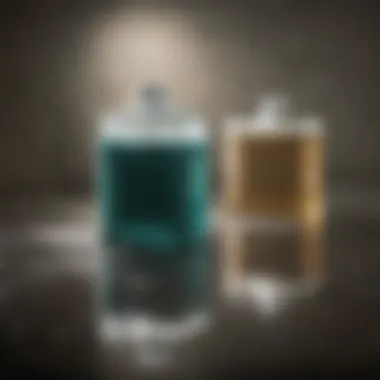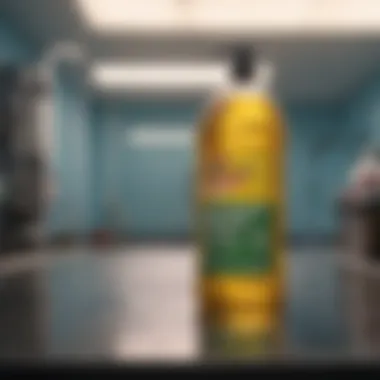Sodium Hypochlorite vs Bleach: Key Differences Explained


Intro
Understanding the nuances between sodium hypochlorite and bleach is crucial for various applications, from industrial processes to household cleaning. Many people use these terms interchangeably, yet they distinctly differ in composition, function, and safety. This analysis aims to clarify these differences while discussing their respective roles in diverse contexts.
Sodium hypochlorite, a compound with the chemical formula NaOCl, is a powerful disinfectant and bleaching agent. It is commonly found in cleaning products and water treatment processes. On the other hand, bleach, often referred to as household bleach, typically contains sodium hypochlorite as its active ingredient, but can also encompass other formulations. This variation can lead to misconceptions regarding their efficacy and proper usage.
As we delve deeper, we will explore the chemical properties that define each substance. The focus will be on their effectiveness in disinfection, stain removal, and safety considerations, particularly in terms of environmental impact and human health. By the end of this analysis, readers will have a clearer understanding of when to use sodium hypochlorite versus conventional bleach, along with the implications of their usage in both domestic and industrial settings.
Prologue
The topic of sodium hypochlorite and bleach holds significant relevance in both industrial and domestic contexts. Understanding these two chemical compounds contributes to effective use in disinfection, cleaning, and various chemical processes. This exploration is essential for a few reasons.
Firstly, sodium hypochlorite is often utilized as a powerful sanitizing agent in water treatment facilities. Its ability to eliminate pathogens is vital for ensuring safe drinking water, yet its characteristics are frequently misunderstood. Conversely, household bleach, which commonly contains sodium hypochlorite, is also a staple for disinfecting surfaces and laundry applications. However, the similarities and differences between these substances can lead to confusion regarding their proper use and safety precautions.
Secondly, an in-depth analysis allows researchers and practitioners to make informed decisions regarding what product to use under specific conditions. Each compound exhibits unique effectiveness against various types of contaminants. By examining research studies, best practices, and regulatory standards, one can identify optimal applications.
Furthermore, safety considerations must not be overlooked. Both sodium hypochlorite and bleach can pose health risks if not handled correctly. It is essential for users to comprehend the precautions necessary when working with these chemicals, especially in diverse settings.
Lastly, addressing misconceptions surrounding sodium hypochlorite and bleach can foster more responsible usage. Common beliefs about their functionality or environmental impact often stem from a lack of understanding about their chemical nature. By offering clarity, this article aims to serve as a reliable resource for students, researchers, educators, and professionals.
Chemical Composition
Understanding the chemical composition of sodium hypochlorite and bleach is essential for grasping their properties and applications. The composition determines how these substances interact in different environments and how effective they can be in certain situations. It forms the basis of their use as disinfectants, and it also plays a critical role in safety considerations and environmental impact.
Sodium Hypochlorite
Sodium hypochlorite is a compound that consists primarily of sodium, oxygen, and chlorine. Its chemical formula is NaOCl. It is notable for its strong oxidizing properties, meaning it can eliminate a range of pathogens efficiently. This characteristic makes it a favored choice in water treatment processes and various industrial applications. The stable form of sodium hypochlorite allows for its ease of use, especially when diluted in water, resulting in a solution that can vary in concentration from household cleaners to industrial-grade disinfectants.
Additionally, sodium hypochlorite is produced through the reaction of chlorine gas with sodium hydroxide. This method crystallizes the crucial relationship between these chemicals and how pure sodium hypochlorite can be achieved. When used properly, sodium hypochlorite effectively decontaminates surfaces, water, and other materials.
Common Bleach Composition
Common bleach, often associated with household cleaning products, typically contains sodium hypochlorite as its main active ingredient. However, it can also include other components such as water, sodium carbonate, and various surfactants that enhance its ability to clean and disinfect. The concentration of sodium hypochlorite in household bleach solutions can range from 3% to 8%, while industrial bleach may go up to 15% to 20% concentration.
The formulation can affect effectiveness and safety. For instance, household versions with lower concentrations are less likely to cause harm but may be less effective in removing tougher stains or disinfecting compared to higher concentrations used in professional settings. Understanding the composition allows users to select the appropriate type of bleach for their particular needs, whether it is for disinfecting laundry or for heavier applications in industrial maintenance.
Sodium hypochlorite and the broader category of bleach share significant overlaps in chemical makeup, but their intended uses and formulation variations highlight important distinctions relevant for consumers and professionals alike.
"The efficacy of sodium hypochlorite stems from its potent oxidizing properties, essential for effective disinfection."
By comprehending the chemical compositions of these materials, one gains deeper insight into not only their capabilities but also the potential risks they may pose in everyday use.
Manufacturing Processes
Understanding the manufacturing processes of sodium hypochlorite and bleach is crucial for several reasons. First, it provides insight into the scale and efficiency of production, which directly influences market availability and price. Second, it highlights considerations regarding the safety guidelines that must be adhered to in order to minimize hazards in both industrial and consumer settings. Lastly, awareness of the manufacturing processes can ignite innovations in production techniques, allowing for more sustainable and eco-friendly practices.
Production of Sodium Hypochlorite
The production of sodium hypochlorite typically occurs through a process called electrolysis. In this method, a saltwater solution (sodium chloride) is subjected to an electrical current. This reaction separates the salt into its constituent parts: sodium ions and chloride ions. These ions then interact to form sodium hypochlorite.
This method is significant due to its direct relation to the purity and concentration of the sodium hypochlorite produced. The electrolysis process is capable of being adjusted to produce varying concentrations, catering specifically to different industrial applications.
Furthermore, the byproducts are primarily salt and oxygen, making the process relatively benign in terms of environmental impact. This is important, as industries are often scrutinized for their contributions to pollution. The efficiency with which sodium hypochlorite can be produced directly affects industries such as water treatment, where maintaining a constant and effective supply is vital.
Bleach Production Methods
Bleach, in general formulations, is often produced by different chemical reactions, primarily involving sodium hypochlorite and hydrogen peroxide. The methods used can vary based on the final product desired. A common method involves mixing sodium hydroxide with chlorine gas, leading to the formation of sodium hypochlorite as the primary component of household bleach.


Another method involves chlorine reacting with water to produce hypochlorous acid, which can then be further processed to make sodium hypochlorite. This flexibility in production methods allows manufacturers to optimize for cost and desired concentration of the bleach product.
While the production of bleach is efficient, it does carry some safety concerns, primarily due to the gas chlorine, which is toxic. Hence, strict safety protocols are in place during manufacturing to protect workers and the surrounding community.
In summary, both sodium hypochlorite and bleach share a common thread in their manufacturing processes, focusing on safety and efficiency. Understanding these processes is key, not only for industrial applications but also for consumer safety and environmental sustainability.
"The efficiency of sodium hypochlorite production can significantly influence the effectiveness of water treatment processes."
Uses and Applications
The uses and applications of sodium hypochlorite and bleach are critical aspects of their overall significance. Understanding how each substance is utilized provides insight into their functionalities and benefits across various fields. Their widespread application indicates their importance in both industrial and domestic settings. By examining specific instances, we can better appreciate why these chemical agents are preferred in certain scenarios over others.
Sodium Hypochlorite in Industries
Water Treatment
Water treatment is a primary application of sodium hypochlorite. It is commonly used for disinfecting drinking water and wastewater. This chemical effectively kills bacteria, viruses, and other pathogens, ensuring safe water supply. The key characteristic here is its strong oxidizing properties. It breaks down harmful microorganisms by disrupting their cellular functions. This makes sodium hypochlorite a beneficial choice in water treatment processes.
One unique feature of water treatment with sodium hypochlorite is its ability to remain stable in diluted forms, allowing for easy storage and handling. However, it must be noted that its overdose can lead to harmful byproducts. Therefore, precise dosing is crucial.
Textile Industry
In the textile industry, sodium hypochlorite plays an essential role in bleaching fabrics. It is effective in removing color from textiles and provides an excellent whitening effect. This characteristic is particularly valued in producing white and bright-colored fabrics. Additionally, it can be adjusted for various strengths depending on the fabric type.
A unique feature of sodium hypochlorite in textiles is its control over coloration processes. Nevertheless, the use of sodium hypochlorite can weaken the fabric's structural integrity if not used properly. Hence, careful application is necessary for maintaining quality.
Paper Production
Sodium hypochlorite is also employed in paper production to bleach and whiten pulp. Its role in this process contributes to the smoothness and brightness of the final product. The key attribute here is its bleaching efficiency, which allows for high-quality paper.
The unique feature of using sodium hypochlorite in paper production is its capacity to achieve desired whiteness levels quickly. However, it is imperative to manage its use effectively as excessive application can affect the paper’s quality and increase environmental concerns.
Household Bleaching Agents
Disinfecting Surfaces
In homes, bleach is widely used for disinfecting surfaces. It is effective against various pathogens, making it an essential cleaning agent in kitchens and bathrooms. The strong sanitizing effect of bleach highlights its value in maintaining hygiene.
One unique function is its ability to provide a visual cue. For instance, the distinct smell of bleach indicates its presence, allowing users to recognize its application. However, proper ventilation is necessary while using bleach due to the high toxicity involved.
Laundry Applications
Bleach is a familiar component in laundry applications. It is commonly added to wash whites, enhancing their brightness and removing stains. The key characteristic here is its stain-fighting power, often making it a preferred choice for many households.
One of the unique features of bleach in laundry is its compatibility with various detergents. However, one must be cautious as bleach can deteriorate certain fabrics. Additionally, overuse can lead to yellowing over time, requiring careful measurement and dilution.
Stain Removal
Stain removal is another critical application for bleach. It effectively breaks down organic stains, such as those from food and drink. This property makes it a useful agent in household cleaning.
The unique feature here is bleach’s rapid action on numerous stains, providing quick results to users. Still, it is important to note that some surfaces or materials may be sensitive to bleach, necessitating testing on inconspicuous areas first.
Effectiveness as a Disinfectant
The effectiveness of sodium hypochlorite and bleach as disinfectants is a critical topic in the realms of public health and safety. This section delves into how well these substances perform in killing pathogens, as this directly impacts their utility across various settings. The growing concerns regarding microbial resistance and emerging infectious diseases accentuate the importance of understanding the capabilities of these disinfectants.
Both sodium hypochlorite and bleach are widely recognized for their disinfecting properties, especially during outbreaks of contagious diseases. Their roles in sanitizing environments, from hospitals to homes, cannot be overstated. This part examines their effectiveness from a scientific and practical perspective, providing readers with a clear understanding of how to utilize these substances efficiently.
Efficacy of Sodium Hypochlorite


Sodium hypochlorite, a compound often used in commercial cleaning products, is highly effective as a disinfectant. Studies show that it can eliminate a wide range of bacteria, viruses, and fungi. When diluted properly, it acts rapidly to kill pathogens on surfaces, making it a preferred choice in settings requiring sterile conditions.
The recommended concentration for disinfecting surfaces is typically between 1000 to 5000 ppm (parts per million). In many cases, sodium hypochlorite solutions can eradicate organisms such as E. coli, Salmonella, and even more resilient viruses like norovirus.
Sodium hypochlorite's mode of action is primarily through oxidation. It disrupts the cellular functions of microorganisms, rendering them incapable of replication. This mechanism not only leads to the death of the pathogens but also contributes to the reduction of contamination in water treatment processes.
Bleach Disinfecting Properties
Bleach, commonly understood as household bleach, usually refers to sodium hypochlorite solutions. Therefore, its disinfecting properties are intimately tied to those of sodium hypochlorite itself. Household bleach solutions can also achieve remarkable efficacy against various pathogens when used correctly.
Pre-diluted household bleach typically contains around 5-6% sodium hypochlorite. This concentration is effective for general disinfecting purposes. As with sodium hypochlorite, the effectiveness of bleach is contingent upon proper use, including contact time and surface preparation.
The factors influencing bleach's efficacy include:
- Concentration: Higher concentrations yield faster results.
- Contact Time: Longer exposure to the bleach solution improves pathogen elimination.
- Surface Type: Porous surfaces may absorb bleach and reduce its effectiveness.
Utilized in the right context, bleach solutions are capable of inactivating bacteria, fungi, and viruses present on surfaces. As such, using bleach properly contributes significantly to infection control in environments ranging from homes to healthcare facilities.
In summary, sodium hypochlorite and bleach demonstrate substantial effectiveness as disinfectants across various applications, making them essential in maintaining health and hygiene in different settings.
Safety Considerations
Safety considerations regarding sodium hypochlorite and bleach are paramount in both industrial and domestic contexts. Understanding the safety profile of these chemicals helps to prevent accidents and ensures that users can handle them responsibly. Given their widespread applications, it is crucial to be aware of risks and necessary safety measures when using these substances.
Toxicity of Sodium Hypochlorite
Sodium hypochlorite is a powerful disinfectant, but it also has associated toxicity. When inhaled or ingested, this chemical can cause harm. Inhalation of its vapors can lead to respiratory irritation, coughing, or difficulty breathing. Skin contact may result in burns or irritation. Thus, it is essential to employ protective equipment such as gloves and safety goggles when handling sodium hypochlorite. In cases of exposure, individuals should seek medical assistance promptly. Regular monitoring of exposure levels and ensuring adequate ventilation in working environments also helps mitigate health risks.
Hazards Related to Bleach
Bleach, commonly referring to sodium hypochlorite, presents several hazards as well. Besides the toxicity discussed earlier, bleach can react with various chemicals, producing harmful gases such as chlorine. When mixed with ammonia, bleach creates a toxic gas that can cause severe respiratory problems. Users must meticulously follow instructions on dilution and avoid combining bleach with other cleaning agents.
Moreover, bleach may degrade surfaces and materials over time, which can lead to economic loss in industrial settings. Proper storage is also a concern; bleach should be stored in tightly sealed containers away from heat sources and incompatible substances. Ensuring awareness and education regarding these hazards is essential for safe handling practices.
"Inadequate knowledge of bleach's hazards can lead to detrimental health effects and material damage."
Environmental Impact
The environmental impact of chemical substances like sodium hypochlorite and bleach is an increasingly important topic. As populations grow and industries expand, the need for effective and safe substances must be balanced against their potential harm to ecosystems. Both sodium hypochlorite and bleach are effective disinfectants, but their effects on the environment can differ significantly. Understanding these elements is crucial for decision-makers in various fields, from manufacturing to environmental science.
Sodium Hypochlorite Environmental Concerns
Sodium hypochlorite, often used in water treatment and sanitation, presents specific environmental concerns. Its main issue lies in its tendency to form toxic byproducts, particularly when reacting with organic materials or pollutants in water bodies. These byproducts can be harmful to aquatic life, leading to decreased biodiversity in affected areas. Moreover, sodium hypochlorite can contribute to chlorine gas emissions which, when released, may pose health hazards to nearby communities.
Uncontrolled releases into soil or water bodies can result in soil degradation and groundwater contamination. Additionally, the persistence of chlorinated compounds in the environment raises alarms about long-term ecological consequences.
Bleach and Water Quality Issues
Bleach, usually a solution of sodium hypochlorite, shares similar water quality issues. When bleach is improperly disposed of, it can enter waterways, affecting water quality. The high concentration of chlorine in bleach reacts with organic materials, forming potentially harmful compounds like trihalomethanes (THMs). These byproducts are associated with health risks, including cancer, if they enter drinking water supplies.
Considering the extensive use of bleach in households and industries, effective disposal and management practices are necessary. Furthermore, regulations need to be firmly established and enforced to reduce potential adverse impacts on water quality.
Proper management of sodium hypochlorite and bleach is essential to safeguard our water sources. Public awareness, along with stringent regulations, can mitigate negative environmental impacts.
In summary, while sodium hypochlorite and bleach are invaluable in their applications, their environmental impact must be adequately addressed to ensure a sustainable balance between utility and ecological safety.
Regulatory Standards


Understanding regulatory standards is crucial, especially in discussions involving substances like sodium hypochlorite and bleach. These standards ensure that the production, handling, and application of these chemicals meet safety and environmental criteria. Regulatory frameworks help protect public health and the environment from potential harms associated with improper use or accidental exposure. They guide manufacturers in maintaining quality and compliance, while also helping consumers choose products that are safe and effective.
Effective regulation can prevent misuse and reduce risks associated with these powerful chemicals. Regulations often encompass areas such as labeling, permissible concentration limits, and safety data sheets. This means consumers and professionals alike should be aware of the relevant standards that apply to their specific context.
Sodium Hypochlorite Regulations
Sodium hypochlorite is primarily regulated under guidelines established by environmental and public health agencies. In the United States, the Environmental Protection Agency (EPA) oversees its use, particularly in water treatment facilities. Regulations stipulate that sodium hypochlorite must meet specific purity standards. This is significant because contaminants can reduce effectiveness and pose health risks.
Key points regarding sodium hypochlorite regulations include:
- Labeling Requirements: Products must clearly display concentration and safety information.
- Permitted Uses: Regulations detail approved applications, aligning use with safety standards.
- Safety Data Sheets: Required documentation must be provided to users, outlining potential hazards and safety practices.
These regulations aim to minimize any adverse effects on human health and the environment while ensuring that sodium hypochlorite is used effectively in its intended applications.
Bleach Manufacturing Standards
The production of bleach, including sodium hypochlorite based products, is governed by specific manufacturing standards. These standards help ensure product quality and consistency across different brands and formulations. American National Standards Institute (ANSI) and similar organizations often set these guidelines.
Critical aspects of bleach manufacturing standards include:
- Quality Control: Manufacturers must implement rigorous testing to ensure that the end product is free from harmful substances and meets minimum active ingredient percentages.
- Production Practices: Clean and safe production environments are mandated to avoid contamination.
- Consumer Safety: Provisions are in place to ensure that the product is safe for household and industrial use, including guidelines for its packaging and distribution.
Common Misconceptions
Understanding the common misconceptions surrounding sodium hypochlorite and bleach is crucial for both personal safety and informed usage in various applications. These myths can lead to improper handling or expectations about the effectiveness of these substances. Recognizing and addressing these misunderstandings ensures that users are better equipped to utilize sodium hypochlorite and bleach safely and effectively.
Sodium Hypochlorite Misunderstandings
One prevalent misunderstanding is that sodium hypochlorite and bleach are fundamentally the same substance. While sodium hypochlorite is indeed the active ingredient in most household bleaches, not all bleach products consist solely of sodium hypochlorite. Many commercial bleach formulations contain varying concentrations and additional compounds that influence their cleaning and disinfecting properties.
Another misconception is regarding the strength and efficacy of sodium hypochlorite as a disinfectant. Some believe that higher concentrations are always more effective in killing pathogens. However, this is not entirely accurate. The effectiveness of sodium hypochlorite depends on factors such as concentration, contact time, and the type of microorganism being targeted. For instance, a lower concentration of sodium hypochlorite can be just as effective against certain bacteria when given sufficient contact time.
Many individuals also underestimate the potential hazards associated with sodium hypochlorite. It is often perceived as harmless because of its common household use. Notably, this compound can release chlorine gas when mixed with acids or ammonia, creating hazardous situations. Hence, proper knowledge about its handling and potential reactions is essential.
Bleach Myths
Common myths surrounding bleach include the idea that it is universally safe for all types of cleaning and disinfection. While bleach is effective against a wide range of microorganisms, its application is not suitable for all surfaces. For instance, using bleach on metals can lead to corrosion, and it is not recommended on certain fabrics, as it can cause discoloration.
Another frequent myth is that bleach can effectively remove all stains. While it can help in some cases, it does not work on all substances. In fact, some stains, like those from organic materials, may become more pronounced when treated with bleach.
Additionally, many consider bleach to be a complete sanitizing solution. While bleach does kill many germs, it is not guaranteed to eliminate all types of pathogens. Therefore, relying solely on bleach for sanitation can provide a false sense of security. Understanding these myths is essential for applying bleach appropriately and safely.
Bleach and sodium hypochlorite serve specific roles, but misconceptions can lead to misuse and safety hazards.
In summary, clarifying these misconceptions helps individuals and professionals approach the use of sodium hypochlorite and bleach with a more educated perspective. Misunderstandings can not only compromise effectiveness but can also pose health risks. By dissecting these myths, we empower users to make informed choices.
Finale
In this comprehensive exploration of sodium hypochlorite and bleach, it is essential to emphasize the significance of understanding these substances. The conclusion serves as a focal point, summarizing the multifaceted nature of sodium hypochlorite and bleach while reinforcing their relevance in both industrial and domestic settings.
Importance of Understanding Sodium Hypochlorite and Bleach
First, clarity surrounding the chemical properties of sodium hypochlorite is crucial. Its role as a powerful disinfectant cannot be understated. Furthermore, knowing its applications helps users apply it effectively and safely in various contexts, from water treatment to sanitation in healthcare.
Similarly, household bleach, commonly recognized in daily life, warrants understanding too. Many consumers utilize bleach without fully grasping its chemical make-up or potential hazards. Recognizing the differences between various bleach formulations helps users choose the right product for their needs.
Comparing Applications and Safety Considerations
Another key element of the conclusion is the juxtaposition of applications and safety considerations of both substances. Users must be informed about the ideal usage scenarios to prevent misuse. Recognizing the effectiveness of sodium hypochlorite in specific situations, such as high-level disinfection, can prevent health risks associated with improper application. Additionally, addressing the safety concerns linked to bleach helps in minimizing associated hazards when used in households.
Environmental and Regulatory Aspects
The environmental impact is a prominent issue amidst growing ecological concerns. Sodium hypochlorite and bleach both raise questions regarding their long-term effects on ecosystems. The conclusion reinforces the necessity for adhering to regulatory standards to ensure safe usage and mitigate environmental risks.
"Understanding the implications of using these substances provides a foundation for responsible and informed use."















